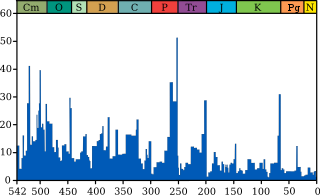| Taghanic event 386 million years ago in Middle Devonian period | |
|---|---|
| 387.7 ± 0.8 – 382.7 ± 1.6 Ma PreꞒ Ꞓ O S D C P T J K Pg N ↓ | |
| Chronology | |
| Preceded by | Taghanic event 386 million years ago in Early Devonian period |
| Followed by | Taghanic event 386 million years ago in Late Devonian period |
The Taghanic event (Taghanic unconformity, Taghanic crisis or Taghanic onlap) was an extinction event that occurred about 386 million years ago during the Givetian faunal stage of the Middle Devonian geologic period in the Paleozoic era. It was caused by hypoxia from an anoxic event. The event had a period in which dissolved oxygen in the Earth's oceans was depleted. The Taghanic event caused a very high death rate of corals. The loss of the coral reefs caused a high loss of animals that lived in and around the reefs. The extinction rate has been placed between 28.5 and 36%, making the event the 8th largest extinction event recorded. The reduced oxygen levels resulted from a period of global warming caused by Milankovitch cycles. In the Taghanic event sea levels were higher. After the Taghanic Event, sea life recovered in the Frasnian faunal stage starting 382.7 million years ago. Two other events near this period were the Kellwasser event (372 ma) and the Hangenberg event (359 ma).
Extinctions
The Taghanic event at the Givetian/Frasnian boundary caused many extinctions, including the disappearance of about 50% of coral genera. Brachiopods Mollusca lost about six families of species. About 47% Stromatoporoid sea sponges genera disappeared. Many Bryozoa were also lost. The population of Ammonoids, Tabulata, Trilobites, and Rugosa were reduced. Thamnopora boloniensis, a tabulate coral, became extinct.
Sediments
Old Red Sandstone continent sediments have been studied to evaluate the Taghanic extinction event. The Taghanic event was discovered by studying sudden sedimentary layer changes, faunal changes, and palaeobiogeographic events. The Taghanic event is found in the Tully Formation and Marcellus Formation in New York and Pennsylvania, including the Windom shale there. The Mahantango Formation in Pennsylvania, West Virginia, and Maryland also record the Taghanic event. The Taghanic event has been found in Tafilalt, Morocco in the eastern Anti-Atlas mountain range. The Orcadian Basin in Scotland has exposed rocks from the Taghanic event.
Taghanic onlap
The period of global warming that caused the Taghanic event melted ice caps causing sea levels to rise. This caused the Taghanic onlap, the submergence of land by the advancing sea. The advancing sea laid down strata deposits on the seafloor. The flooding of what is now the southwestern United States created a shallow marine environment.
Gallery


-
 Marcellus Formation Shale from Middle Devonian sedimentary rock, location of the Taghanic event rocks
Marcellus Formation Shale from Middle Devonian sedimentary rock, location of the Taghanic event rocks
-
 Windom shale, location of Taghanic event rocks
Windom shale, location of Taghanic event rocks
-
 Tully Formation at Taughannock Falls State Park, location of the Taghanic event rocks
Tully Formation at Taughannock Falls State Park, location of the Taghanic event rocks
See also
References
- Marshall, John E. A.; Brown, John F.; Astin, Timothy R. (April 15, 2011). "Recognising the Taghanic Crisis in the Devonian terrestrial environment and its implications for understanding land–sea interactions". Palaeogeography, Palaeoclimatology, Palaeoecology. 304 (1): 165–183. Bibcode:2011PPP...304..165M. doi:10.1016/j.palaeo.2010.10.016 – via ScienceDirect.
- Sepkoski, J. John (December 18, 1996). Walliser, Otto H. (ed.). Global Events and Event Stratigraphy in the Phanerozoic: Results of the International Interdisciplinary Cooperation in the IGCP-Project 216 "Global Biological Events in Earth History". Springer. pp. 35–51. doi:10.1007/978-3-642-79634-0_4 – via Springer Link.
- ^ Johnson, J. G. (1970). "Taghanic Onlap and the End of North American Devonian Provinciality". Geological Society of America Bulletin. 81 (7): 2077. Bibcode:1970GSAB...81.2077J. doi:10.1130/0016-7606(1970)81[2077:TOATEO]2.0.CO;2.
- Feist, R.; Klapper, G. (2021). "Phacopid trilobites in post-Taghanic Givetian through Frasnian cephalopod limestones, Montagne Noire (France) and related areas (Thuringia, Morocco)". Bulletin of Geosciences. 97 (1): 1–32. doi:10.3140/bull.geosci.1834. S2CID 246358282.
- ^ "Abstract: THE TAGHANIC EVENT: A LATE MID DEVONIAN ARIDITY CRISIS (2003 Seattle Annual Meeting (November 2–5, 2003))". gsa.confex.com.
- ^ "Late Devonian - an overview | ScienceDirect Topics". www.sciencedirect.com.
- McGhee Jr GR, Clapham ME, Sheehan PM, Bottjer DJ, Droser ML (January 2013). "A new ecological-severity ranking of major Phanerozoic biodiversity crises". Palaeogeography, Palaeoclimatology, Palaeoecology. 370: 260–270. Bibcode:2013PPP...370..260M. doi:10.1016/j.palaeo.2012.12.019. ISSN 0031-0182.
- Helling, Stephan; Becker, Ralph Thomas (September 1, 2022). "Two new species of Gondwanaspis (Trilobita, Odontopleurida) from the Givetian-Frasnian transition of the northern Rhenish Massif (Germany)". Palaeobiodiversity and Palaeoenvironments. 102 (3): 697–709. Bibcode:2022PdPe..102..697H. doi:10.1007/s12549-022-00525-3.
- Bridge, Tom C. L.; Baird, Andrew H.; Pandolfi, John M.; McWilliam, Michael J.; Zapalski, Mikołaj K. (January 26, 2022). "Functional consequences of Palaeozoic reef collapse". Scientific Reports. 12 (1): 1386. Bibcode:2022NatSR..12.1386B. doi:10.1038/s41598-022-05154-6. PMC 8792005. PMID 35082318.
- Aboussalam, Z. Sarah; Becker, R. Thomas (April 15, 2011). "The global Taghanic Biocrisis (Givetian) in the eastern Anti-Atlas, Morocco". Palaeogeography, Palaeoclimatology, Palaeoecology. 304 (1): 136–164. Bibcode:2011PPP...304..136A. doi:10.1016/j.palaeo.2010.10.015 – via ScienceDirect.
- Graham, John Paul. "Devonian carbonate rocks , Plate8.jpg". ir.library.oregonstate.edu.
- "Abstract: Global Taghanic and Givetian Seawater Records: An Amelioration of Faunal Realms, Climatic Conditions and High Levels of Atmospheric Carbon Dioxide ( 2008 Joint Meeting of The Geological Society of America, Soil Science Society of America, American Society of Agronomy, Crop Science Society of America, Gulf Coast Association of Geological Societies with the Gulf Coast Section of SEPM)". gsa.confex.com.